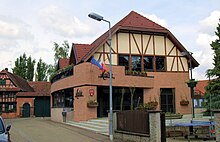Eckwersheim
| Eckwersheim | ||
|---|---|---|

|
|
|
| region | Grand Est | |
| Department | Bas-Rhin | |
| Arrondissement | Strasbourg | |
| Canton | Brumath | |
| Community association | Eurométropole de Strasbourg | |
| Coordinates | 48 ° 41 ′ N , 7 ° 42 ′ E | |
| height | 139-183 m | |
| surface | 7.46 km 2 | |
| Residents | 1,328 (January 1, 2017) | |
| Population density | 178 inhabitants / km 2 | |
| Post Code | 67550 | |
| INSEE code | 67119 | |
Eckwersheim is a French commune with 1,328 inhabitants (as of January 1, 2017) in the canton of Brumath in the Bas-Rhin department in the Grand Est region (until 2015 Alsace ). The inhabitants are called Eckwersheimois .
history
middle Ages
The village was a fiefdom of the Bishop of Metz . It belonged to the rule of Oberbronn , which is documented from the 13th century and belonged to a number of noble families one after the other. At first it was the Lords of Ochsenstein . After a lost feud between the Ochsensteiners, the Lords of Lichtenberg tried to gain possession of the village in 1451, a project to which the feudal lord , the Bishop of Metz , refused to approve. When the von Ochsenstein family died out in 1485, their inheritance came to the Counts of Zweibrücken-Bitsch .
Early modern age
The rulership of Oberbonn - and with it Eckwersheim - came from Zweibrücken-Bitsch to this family in 1551 as a dowry on the occasion of the marriage of Amelie von Zweibrücken-Bitsch to Philip I of Leiningen-Westerburg . As a successor to the Leininger, the Landgraves of Hessen-Homburg and, to a lesser extent, the Swedish aristocratic family of the Barons von Sinclair became lords of Oberbronn and the village of Eckwersheim in the 17th century. Due to France's reunion policy , the rule of Oberbronn and the village of Eckwersheim also fell under French suzerainty in the second half of the 17th century. The Hesse-Homburg part passed to the Hohenlohe-Waldenburg-Bartenstein family in the middle of the 18th century , while the Sinclair part went to the von Lewenhaupt family, who were also of Swedish origin . Hohenlohe had to cede the rule to France in 1793 and was later resigned to areas of the secularized diocese of Würzburg .
Modern times
In the course of the reunion policy , the areas to the left of the Rhine - and with it Eckwersheim - fell to France. In the following administrative reforms, the rule of Oberbronn was dissolved.
On the afternoon of November 14, 2015, the Eckwersheim railway accident occurred near Eckwersheim , in which eleven people were killed: The Vendenheim junction is near Eckwersheim , where the new double-track LGV Est européenne line (high-speed line Paris-Strasbourg) after a curve into the existing one The Paris – Strasbourg line ends. A TGV , as a test train , drove the not yet opened high-speed route at too high a speed and was carried out of the curve.

Population development
| 1798 | 1962 | 1968 | 1975 | 1982 | 1990 | 1999 | 2006 | 2012 |
|---|---|---|---|---|---|---|---|---|
| 560 | 669 | 670 | 771 | 906 | 1,112 | 1,266 | 1,425 | 1,370 |
Economy and Infrastructure
In the community mainly arable farming is practiced.
Eckwersheim is served by the Compagnie des transports strasbourgeois bus route 71.
Attractions
- Evangelical Lutheran Church
Personalities
- Johannes Michel (* 1863), notary and member of the state parliament
literature
- Jean-Claude Brumm: Quelques dates importantes dan l'histoire… . In: Société d'Histoire et d'Archaeologie de Saverne et Environs (ed.): Cinquième centenaire de la création du Comté de Hanau-Lichtenberg 1480–1980 = Pays d'Alsace 111/112 (2, 3/1980), p 10f.
- Fritz Eyer: The territory of the Lords of Lichtenberg 1202-1480. Investigations into the property, the rule and the politics of domestic power of a noble family from the Upper Rhine . In: Writings of the Erwin von Steinbach Foundation . 2nd edition, unchanged in the text, by an introduction extended reprint of the Strasbourg edition, Rhenus-Verlag, 1938. Volume 10 . Pfaehler, Bad Neustadt an der Saale 1985, ISBN 3-922923-31-3 (268 pages).
- Friedrich Knöpp: Territorial holdings of the County of Hanau-Lichtenberg in Hesse-Darmstadt . [typewritten] Darmstadt 1962. [Available in the Hessisches Staatsarchiv Darmstadt , signature: N 282/6].
- Alfred Matt: Bailliages, prévôté et fiefs ayant fait partie de la Seigneurie de Lichtenberg, du Comté de Hanau-Lichtenberg, du Landgraviat de Hesse-Darmstadt . In: Société d'Histoire et d'Archaeologie de Saverne et Environs (eds.): Cinquième centenaire de la création du Comté de Hanau-Lichtenberg 1480–1980 = Pays d'Alsace 111/112 (2, 3/1980), p 7-9.
- Peter Karl Weber: Lichtenberg. Alsatian domination on the way to becoming a territorial state. Social costs of political innovation . Heidelberg 1993.
Web links
Individual evidence
- ↑ Knöpp, p. 4.
- ^ Weber, p. 37, note 59.
- ↑ Eyer, p. 74
- ↑ Waltz and Rudolph.
- ^ Gerhard Köbler : Historical Lexicon of the German Lands. The German territories from the Middle Ages to the present. 7th, completely revised edition. CH Beck, Munich 2007, ISBN 978-3-406-54986-1 , p. 481: Keyword: Oberbronn (Herrschaft).
- ^ Matt, p. 7.
- ↑ See: Kathrin Ellwardt: Lutherans between France and the Reich: Church buildings in the Alsatian offices of the County of Hanau-Lichtenberg under Johann Reinhard III. and Louis IX. In: New Magazine for Hanau History 2016, pp. 18–59 (34).


